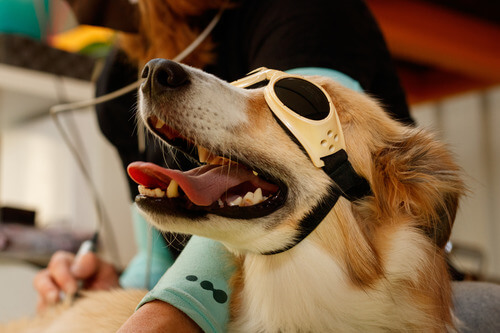Shedding a beam of hope for pet health, light therapy, also known as photobiomodulation, is a burgeoning field. This miraculous technology, once developed exclusively for humans, has now pierced through the veil of veterinary medicine, offering a panacea for a multitude of pet health issues, from arthritis to anxiety.
Harnessing specific light wavelengths, this non-invasive approach works by stimulating complex biological processes within the body. Comparable to the revitalisation of a worn-out battery, it promotes cellular repair, reduces inflammation and, above all, is often perceived as soothing by our furry friends.
Table of Contents
Illuminating the Mechanism: The Science Behind Light Therapy
In the mystical world of cellular biology, the mighty mitochondria, often dubbed the “powerhouses,” play a pivotal role in light therapy. These micro power stations, when triggered by specific light wavelengths, produce more adenosine triphosphate (ATP), the essential fuel for biological functions.
The heightened energy production fast-tracks healing, improves circulation, and dampens inflammation. This deeply penetrating technology, capable of reaching tissues without compromising the skin’s integrity, offers a valuable alternative to invasive surgeries or drug interventions.
Why Light Therapy Shines for Pets
The phenomenal versatility of light therapy is what attracts many pet owners. Whether for treatment of arthritis, muscle injuries, skin irritations, or recovery after surgery, it proves invaluable. This method poses minimal risk, unlike some prescription medications packed with serious side effects.
Also, the therapy’s calming influence shows a marked improvement in animals grappling with anxiety induced by separation or environmental change. As part of a comprehensive treatment plan, light therapy complements physical therapy, dietary adjustments, and traditional medical interventions, thus rendering it an appealing, gentle care option for pet owners. Contact Pets HeaLED to learn more about how your pet can benefit.
Understanding Potential Side Effects
Although widely deemed as safe, light therapy can occasionally provoke minor and typically reversible side effects, such as skin redness or sensitivity. Overuse or incorrect calibration of the device can lead to temporary discomfort or irritation, further reiterating the importance of adhering to your vet’s advice on session duration and wavelengths.
Pets with a history of seizures or photosensitivity require extra caution, even though adverse impacts are rare. It’s imperative to consult a professional before embarking on treatment to ensure the selection of a suitable, veterinary-grade device and avoid any mishaps.
Mitigating Risks: A Proactive Approach
To lessen any associated risks, seek guidance from veterinary professionals adept in light therapy. Careful monitoring of your pet’s response during and after treatment is crucial, and any signs of discomfort or behavioural changes should be immediately relayed to your vet for potential adjustments.
Learning is power: every pet owner should know what to expect from treatment and how to safely execute light therapy at home. Collaboration with trusted veterinary professionals will ensure the adequacy of the therapy for your pet’s health and comfort.
Read more : Leading Veterinary Clinics In Thousand Oaks
Illuminate Your Pet’s Health with Therapeutic Light
Bringing together scientific validity and gentle care, light therapy harbours immense potential for improving pet health. Though potential side effects are negligible, understanding the treatment and professional guidance ensure it’s safely navigated. If you want to improve your pet’s quality of life, consider light therapy and consult your vet to learn how this ingenious technology can benefit your furry companion.







